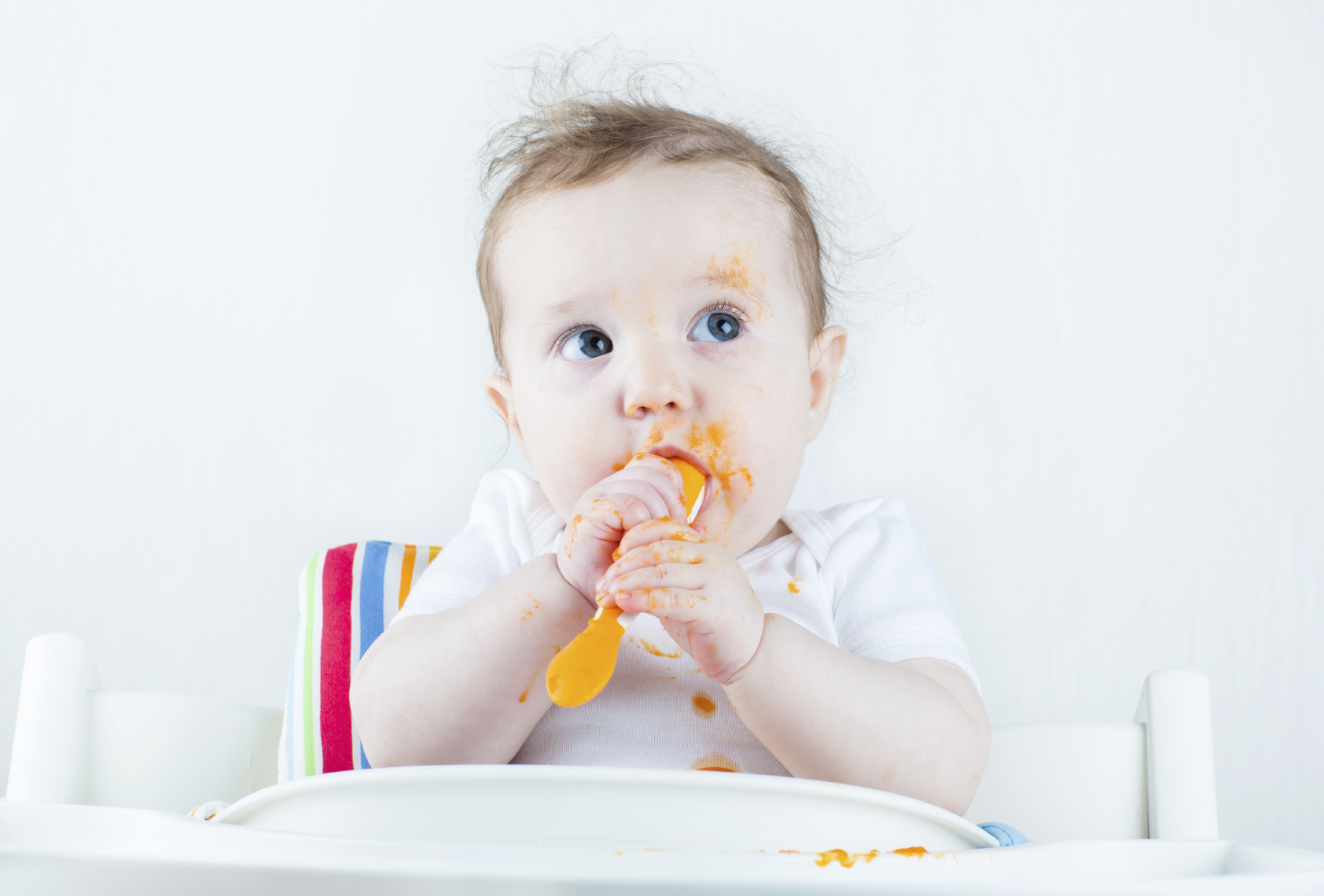
How do you know when it’s time to start your baby on solids? Many factors influence the timing, including neurological and physical development and your family’s schedule. If your baby does all of the following, she’s ready to take this big nutritional step:
- Holds her head and torso upright (sitting up) when propped up or by herself
- Uses her hands to reach for things
- Follows your own spoon or fork as you eat
- Mimics chewing and lip smacking and makes “mmmm” sounds when you eat
Developmental theory states that the brain is primed to begin learning the most about hand-eye coordination, pincer grasp and the social interactions involved in eating meals with others at 3 to 6 months old. Also, foods introduced after a child turns 1 show a higher incidence of allergic response.
When breastfeeding or formula feeding is still the primary source of nutrition, introducing solid foods is more an exercise in exploration and the development of social skills. Children mimic their parents: Picky parent eaters will have picky child eaters. By providing your child with a wide variety of foods, even ones you may not like yourself, you’ll enable him to develop a diverse palate. This will benefit both of you greatly later, minimizing your (and your baby’s) dependence on processed foods.
It is normal for children to develop aversions to specific colors and textures of food, perhaps eating only one color or food for a week or two. Most children get sufficient nutrition from whatever they eat during this time.
Getting started
First foods vary by culture — rice cereal is common in the U.S. Rice is hypoallergenic, but it can be constipating. Avoid this side effect by mixing in baby pear or prune juice, as well as breast milk or formula. Alternatively, start with fruits to avoid the issue altogether. Stone fruits in particular (peaches, plums, cherries, nectarines and avocados) keep the bowels moving freely.
Introduce only one food for two to three days. If your baby has no negative reactions, add one more food and serve both for another two to three days. Then continue adding foods one at a time. If you believe your child is having a negative reaction to a given food, such as rashes or digestive issues, remove that food and try it again in two to three weeks.
Note that orange veggies may cause your baby’s skin to turn orange — this is temporary and of no concern. For some babies, mixing green veggies into the already introduced orange ones is a great way to augment flavor profile without rejection. For many infants, initially disliked foods can be reintroduced a few months later with positive results.
DIY baby food
I recommend purchasing one jar of each “stage” of baby food to see its texture. Baby foods vary from brothlike to thick, with fully cooked pea-size chunks that fall apart when pressed with a spoon. Small finger foods, such as Cheerios and teething biscuits, fall apart when wet.
Meat should be cooked as completely as possible (to the point of falling apart) and cut into bite-size pieces; these are generally not introduced until teeth are in and babies are eating larger chunks of fruits and vegetables. Mash up fish well and make sure all fine bones are removed. Fully cooked eggs are OK starting at 4 to 5 months.
High-nitrate foods (such as carrots and green beans) should be certified organic, as conventionally grown forms may contain too much nitrate for babies’ digestive systems.
Food processors that steam and chop/puree baby food make preparation simple. However, they typically make only one to two cups at a time. For larger batches, which can be frozen in individual portions in ice-cube trays, using steamer baskets or an electric steamer — as well as a larger food processor or food mill — cuts down substantially on prep time. At this stage of baby’s life, avoid highly processed foods and sauces to minimize exposure to artificial flavors and colors and excess sodium.
Causes for concern
It is possible to have your baby tested for food allergies at any age. If a primary family member (older sibling or parent) has a food allergy, I recommend getting these tests done before introducing foods to which the family member is allergic. Note that lactose intolerance is not an allergic reaction, but it can cause discomfort and digestive issues such as gas, bloating and diarrhea.
Hot dogs should always be cut into quarters (or halves as the child gets older) and sliced into bite-size pieces to minimize the choking hazard.
Because of naturally occurring botulism, honey should not be introduced until after baby is 1 year old.
Many highly acidic foods, such as strawberries and tomatoes, can cause rashes or redness around the mouth or rectum. This is due to vitamin C irritating the skin, and it can be reduced by wiping mouths and changing diapers frequently. A soothing lotion for either area, such as calendula-based oil, or A+D cream for the diaper area can help reduce redness and discomfort.











